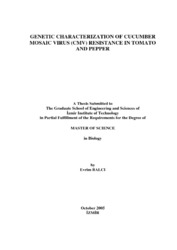Please use this identifier to cite or link to this item:
https://hdl.handle.net/11147/3307Full metadata record
| DC Field | Value | Language |
|---|---|---|
| dc.contributor.advisor | Doğanlar, Sami | - |
| dc.contributor.author | Balcı, Evrim | - |
| dc.date.accessioned | 2014-07-22T13:51:17Z | - |
| dc.date.available | 2014-07-22T13:51:17Z | - |
| dc.date.issued | 2005 | - |
| dc.identifier.uri | http://hdl.handle.net/11147/3307 | - |
| dc.description | Thesis(Master)--İzmir Institute of Technology, Biology, İzmir, 2005 | en_US |
| dc.description | Includes bibliographical references (p.49-55) | en_US |
| dc.description | Text in English; Abstract: Turkish and English | en_US |
| dc.description | x, 55 leaves | en_US |
| dc.description.abstract | In this study, tomato and pepper populations were phenotypically and genotypically characterized to identify cucumber mosaic virus (CMV) resistant lines and determine the genetic control of resistance. Populations of both crops and their resistant and susceptible parents were mechanically inoculated with CMV. Plants were evaluated visually and by enzyme-linked immunosorbent assay (ELISA). Since virus was detected only in inoculated leaves but was not usually present in uninoculated leaves of symptomless plants, CMV resistance appeared to be true resistance not immunity. According to phenotypic analysis of F2 tomato population, it was hypothesized that two dominant genes were controlling resistance as the plants fit a 9:7 (resistant:susceptible) segregation ratio as determined by Chi square goodness-of-fit analysis. In order to perform quantitiative trait locus (QTL) analysis, molecular markers were surveyed for polymorphism using the two parents of the tomato population, L. esculentum and L. hirsutum LA1223. According to QTL analysis (using 107 polymorphic markers), 11 genomic regions were linked to CMV resistance. For seven loci, resistance alleles were coming from the L. hirsutum parent as expected. However, for four loci, resistance was associated with alleles from the CMV susceptible parent, L. esculentum. These results show that the genetic potential for resistance cannot be determined by only looking at the phenotype of the two parents. As a result of this work, developing elite lines or transferring resistance genes into cultivated species by marker assisted selection will be easier. | en_US |
| dc.language.iso | en | en_US |
| dc.publisher | Izmir Institute of Technology | en_US |
| dc.rights | info:eu-repo/semantics/openAccess | en_US |
| dc.subject.lcc | QK981.45 .B17 2005 | en |
| dc.subject.lcsh | Plants--Virus resistance--Genetic aspects | en |
| dc.subject.lcsh | Plant diseases--Genetic aspects | en |
| dc.subject.lcsh | Tomatoes--Diseases and pests | en |
| dc.subject.lcsh | Tomatoes--Genetics | en |
| dc.subject.lcsh | Cucumber mosaic virus | en |
| dc.title | Genetic Characterization of Cucumber Mosaic Virus (cmv) Resistance in Tomato and Pepper | en_US |
| dc.type | Master Thesis | en_US |
| dc.institutionauthor | Balcı, Evrim | - |
| dc.department | Thesis (Master)--İzmir Institute of Technology, Molecular Biology and Genetics | en_US |
| dc.relation.publicationcategory | Tez | en_US |
| dc.identifier.wosquality | N/A | - |
| dc.identifier.scopusquality | N/A | - |
| item.openairecristype | http://purl.org/coar/resource_type/c_18cf | - |
| item.languageiso639-1 | en | - |
| item.openairetype | Master Thesis | - |
| item.grantfulltext | open | - |
| item.fulltext | With Fulltext | - |
| item.cerifentitytype | Publications | - |
| Appears in Collections: | Master Degree / Yüksek Lisans Tezleri | |
Files in This Item:
| File | Description | Size | Format | |
|---|---|---|---|---|
| T000388.pdf | MasterThesis | 2.55 MB | Adobe PDF |  View/Open |
CORE Recommender
Page view(s)
288
checked on Mar 31, 2025
Download(s)
130
checked on Mar 31, 2025
Google ScholarTM
Check
Items in GCRIS Repository are protected by copyright, with all rights reserved, unless otherwise indicated.